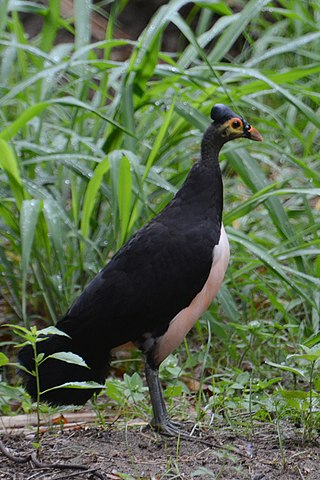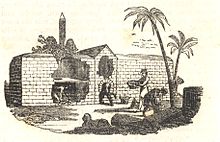
The chicken is a large and round short-winged bird, domesticated from the red junglefowl of Southeast Asia around 8,000 years ago. Most chickens are raised for food, providing meat and eggs; others are kept as pets or for cockfighting.

René Antoine Ferchault de Réaumur was a French entomologist and writer who contributed to many different fields, especially the study of insects. He introduced the Réaumur temperature scale.

Debeaking, beak trimming, or beak conditioning is the partial removal of the beak of poultry, especially layer hens and turkeys although it may also be performed on quail and ducks. Most commonly, the beak is shortened permanently, although regrowth can occur. The trimmed lower beak is somewhat longer than the upper beak. A similar but separate practice, usually performed by an avian veterinarian or an experienced birdkeeper, involves clipping, filing or sanding the beaks of captive birds for health purposes – in order to correct or temporarily to alleviate overgrowths or deformities and better allow the bird to go about its normal feeding and preening activities. Amongst raptor-keepers, this practice is commonly known as "coping".

The megapodes, also known as incubator birds or mound-builders, are stocky, medium-large, chicken-like birds with small heads and large feet in the family Megapodiidae. Their name literally means "large foot" and is a reference to the heavy legs and feet typical of these terrestrial birds. All are browsers, and all except the malleefowl occupy wooded habitats. Most are brown or black in color. Megapodes are superprecocial, hatching from their eggs in the most mature condition of any bird. They hatch with open eyes, bodily coordination and strength, full wing feathers, and downy body feathers, and are able to run, pursue prey, and in some species, fly on the same day they hatch.

Egg incubation is the process by which an egg, of oviparous (egg-laying) animals, develops an embryo within the egg, after the egg's formation and ovipositional release. Egg incubation is done under favorable environmental conditions, possibly by brooding and hatching the egg.

A hatchery is a facility where eggs are hatched under artificial conditions, especially those of fish, poultry or even turtles. It may be used for ex situ conservation purposes, i.e. to breed rare or endangered species under controlled conditions; alternatively, it may be for economic reasons.

Gold Kist was a large chicken producing company in the southern United States. It was founded in 1933 by D.W. Brooks, a University of Georgia agronomy instructor as the Cotton Producers Association, a cooperative to help farmers in Carrollton, Georgia, market cotton. It soon grew and diversified into fields such as fertilizer and retailing farm supplies. It soon entered the poultry business. In 1998 it exited the agronomy business to focus on protein products, primarily chicken but also pork. In 2004, with the approval of its membership, it converted from being a cooperative to a for-profit stock-ownership company, listed on NASDAQ. In 2006, Gold Kist was acquired by Pilgrim's Pride.

Chick culling or unwanted chick killing is the process of separating and killing unwanted chicks for which the intensive animal farming industry has no use. It occurs in all industrialised egg production, whether free range, organic, or battery cage. However, some certified pasture-raised egg farms are taking steps to eliminate the practice entirely. Worldwide, around 7 billion male chicks are culled each year in the egg industry. Because male chickens do not lay eggs and only those in breeding programmes are required to fertilise eggs, they are considered redundant to the egg-laying industry and are usually killed shortly after being sexed, which occurs just days after they are conceived or after they hatch. Some methods of culling that do not involve anaesthetics include: cervical dislocation, asphyxiation by carbon dioxide, and maceration using a high-speed grinder. Maceration is the primary method in the United States. Maceration is often a preferred method over carbon dioxide asphyxiation in western countries as it is often considered as "more humane" due to the deaths occurring immediately or within a second.

The domestic duck is a subspecies of mallard that has been domesticated and raised for meat and eggs. A few are kept for show, as pets, or for their ornamental value. Almost all varieties of domesticated ducks, apart from the domestic Muscovy duck, are descended from the mallard, which was domesticated in China around 2000 BC.

An incubator is a device used to grow and maintain microbiological cultures or cell cultures. The incubator maintains optimal temperature, humidity and other conditions such as the CO2 and oxygen content of the atmosphere inside. Incubators are essential for much experimental work in cell biology, microbiology and molecular biology and are used to culture both bacterial and eukaryotic cells.

The maleo is a large megapode and the only member of the monotypic genus Macrocephalon. The maleo is endemic to Sulawesi and the nearby smaller island of Buton in Indonesia. It is found in the tropical lowland and hill forests, but nests in the open sandy areas, volcanic soils, or beaches that are heated by the sun or geothermal energy for incubation.

Milo Milton Hastings was an American inventor, author, and nutritionist. He invented the forced-draft chicken incubator and Weeniwinks, a health-food snack. He wrote about chickens, science fiction, and health, among other things. Some of his writing is available in book form and on Project Gutenberg. Hastings was married twice and had three children.

An incubator is a device simulating avian incubation by keeping eggs warm at a particular temperature range and in the correct humidity with a turning mechanism to hatch them.

Poultry farming is a part of the United States's agricultural economy.
Keeping chickens as pets, for eggs, meat, or for eating pests is popular in urban and suburban areas. Some people sell the eggs for side income.

Broodiness is the action or behavioral tendency to sit on a clutch of eggs to incubate them, often requiring the non-expression of many other behaviors including feeding and drinking. Being broody has been defined as "Being in a state of readiness to brood eggs that is characterized by cessation of laying and by marked changes in behavior and physiology". Broodiness is usually associated with female birds, although males of some bird species become broody and some non-avian animals also show broodiness.

Chick sexing is the method of distinguishing the sex of chickens and other hatchlings, usually by a trained person called a chick sexer or chicken sexer. Chicken sexing is practiced mostly by large commercial hatcheries to separate female chicks or "pullets" from the males or "cockerels". The females and a limited number of males kept for meat production are then put on different feeding programs appropriate for their commercial roles.

The broiler industry is the process by which broiler chickens are reared and prepared for meat consumption. Worldwide, in 2005 production was 71,851,000 tonnes. From 1985 to 2005, the broiler industry grew by 158%.

Ray Miller Petersime was an American businessman and Christian philanthropist and humanitarian who was active in providing material relief to war-torn Europe after World War II and who secured sponsorship for more than a thousand European displaced persons, permitting their resettlement in the U.S.
The WIMEX Group is an internationally active German company in the meat and agricultural industry, based in Köthen, Saxony-Anhalt. With an annual capacity of 435.455 million hatching eggs, it is the largest producer of day-old chicks for chicken fattening in Europe and one of the world's largest suppliers of broiler chickens of the Cobb breed. Its revenue in 2021 was €295,158 million. Just under 50 percent of the company's shares are owned by the PHW Group.


















